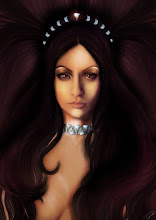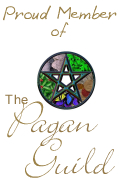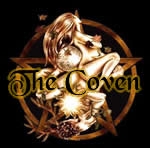Friday, May 16, 2008
VooDoo
Introduction
Voodoo is a system of beliefs, a religion, and a practical magical system with its roots in black Africa.The centers from which voodoo spread thorugh the world and developed are Benin, Togo, Burkina Faso, south-east Gana and Senegal in Africa, where the terms Vodou, Vodoun, Vudu and Vudun are in use, and Haiti, where the term Voudon is in use.The Haiti islands are a specific background, where a special system developed , that consists of original elements and cults form black Africa mixed with creole legacy and catholic cult; further mixing with catholic cults and religion is noticed in Brasil, but we will deal with this later on.
The foundations of voodoo lie in the worship of ancestors and a multitude of Loa or deities, as well as a supreme being, the creators of all Universe.The basic purpose of voodoo as a practical system is to influence daily life, and to communicate with ancestors and deities through which that influence is made possible, and also the travel of the man's soul into spiritually higher realms.Although there are a multitude of Loa (this term signifies the singular as well the plural), we will focus our attention only on main Families of Loa, which are three in number, and which are common to all systems of voodoo.The Loa are forms given to manifestations of the divine force, in order to make easier the communication between them and the human race.That communication is not possible with the Creator, the Supreme Beings, who are away and beyond the realms of human existence, and serve as the upholders of the Creation, the Ones who make certain that all functions well and flows in its course; a good parallel would be Orlog, the eternal law, above humans and gods, from the ancient nordic tradition.Now we will deal with those Supreme Beings and the Loa.
The Supreme Beings
These are the Creators and upholders of the Universe.The common names for this Being are Mawu,Mahou or Mau, Olorun, Oniyama and Olodumare, in different traditions; as said before, these beings cannot be contacted and nothing can be asked of them; it is the Loa who serve this purpose, the intermediate between the Supreme and humanity.In Rada, one of the three main families of Loa, Damballah and Ayida-Wedo are also respected and worshipped; these male and female Supreme Beings are symbolised by two snakes surrounded by rainbows; these two are also of the supreme gods, but their purpose is to give love to all Creation; but, since they cannot understand human tongues, we are again compelled to address the Loa for our purposes.
The Loa
There are three main families of the Loa:
1.Rada Loa: this is a very old family, consisting mainly of benevolent Loa.The most important are Legba, Loko, Ayizan and Erzulie.Their traditional colour is white.
2.Petro Loa: a young Family, very practical and magical.It developed in the New world, so it has not a completely african background.It is said that it formed in the year 1768., on Haiti, through the medium Don Pedro, who himself became a Loa after his death.Other most important Loa are Marinette, Ogun and Carrefour.This family's colour is red.
3.Ghuede Loa: this family consists of the spirits of the dead.They are very powerful in the arts of healing and children protection, but are also tricksters.There are many Loa in this Family, but the most important is the Baron Samedi, who is also called Baron Cimitiere, Baron LaCroix, and Maman Brigitte or Grande Brigitte, where ''Grande'' stands for ''Granny''; she is the female complementary to Baron Samedi, and some say that she is his wife and consort.They are both guardians and protectors of graves and cemeteries, and crossroads, and particularly the central points of the crossroads.Their colours are black and purple, and also red.
The most important Loa
Baron Samedi
He is usually visualised as a man in a black suit, with a skull for his head, black sunglasses, black hat and cotton in his nostrils, just like a corpse ready for burial the Haiti way.He stands in the center of the crossroads, through which souls travel to Guinee (the astral counterpart of Africa, which symbolises the common home of all men, and whose center is Ville-aux-Champs,a city which could be viewed as paradise or Tiphareth); as such he posesses the keys to life, death and resurrection; he's also a very sexual Loa, and is sometimes portraited with his phallus in erection.He loves tobacco and rum.
Bacalou Baca
He is usually viewed as an ''evil'', or ''black'' Loa; he is respected mostly by the ''fazer les zombies'', the black magicians who turn men into zombies, and the ''servir-aux-deux-mains'', magicians who do not practice black magic as a rule, but offer such services for money.
Papa Leghba
He is the Opener of the Gates, spiritual and material, the absolute Initiator, who, as such, is often identified with Christ.He makes possible the communication with the Loa, and is the guardian of spiritual crossroads.He is one of the most revered Loa, and si saluted first in all ceremonies.He is usually represented as an old man smoking a pipe.
Erzulie
A female Loa who has several forms; as Erzulie Freda, she is the epitomy of female sensuality and beauty, the goddess of luxury, love, jewels, and precious stones; her colours are pink, blue and gold.In the form of Erzulie Dantor, she is an old woman with many scars, who in one hand holds a knife, and in the other protectively holds a child; she protects woman and children, and is also associated with protection of gay men and women.She is laso, sometimes and in certain cults, represented as the Black Madonna.She is also Erzulie La Sirene, a form which probably derives form the ancient nigerian snake-goddess Ezi-Aku.
Ogoun
The great Loa of the Rada Family; he also has different forms.This is a male Loa, with all male and martian qualities; he is a warrior, ruling over thunder, storms, swords and all weapons of steel, and guards and protects the warrior in battle.His are the steel and red colur, the colour of blood.As Ogun Badagris, he is a phallic and magical Loa who helps in divination and foretelling, and as Ogun Fer, he is a pure warrior.
Carrefour or Kalfu
''Carrefour'' means ''crossroads''.This Loa controls the crossroads, but the points further away form the centre; he controls the evil spirits, and measures the misfortune, death and disease to be led from the spiritual world into ours.He is the Lord of spells, magic and sorcery.Although he is not the most favourite Loa, he is very respected.
Marassa Jumeaux
These are the divine twins; the Lords of justice, happiness and spiritual wealth.They symbolise the dual nature of the Universe (or Multiverse, as Thorsson would say), and the nature of men and gods and their interaction.
Religions and systems closely conncted to voodoo
Santeria
''Santeria'' means ''the way of saints''.This religion rerspects the Supreme beings Olorun and Olodumare, male and female, the Cretaors of the Universe, and the lower spirits, the Orisha, and also the Ara Orun, ''people of the sky'', who are the souls of the ancestors.This religion derives form the old Lukumi religion, practiced among the Yoruba people, and this word Lukumi derives form the ancient word Olukumi, which means ''my friend''; I think that this word explains a lot of the interaction between the Orisha, the ancestors and the faithful.Santeria, as is today, appeared for the first time in XVIII century on Cuba.As the religion of the slaves, it was practically outlawed, and hence the identification of many Orishas with catholic saints, which served as a disguise for them and thie cult.This religion is ''responsible'' for connecting voodoo with the sacrifice of animals, since it is regular poractice to sacrifice chickens, in order to satsify the Orishas thirst for blood, which is satisfied when the mediums, posessed by the spirits, drink the blood of ther animals.However, this practice is discarded by the esotheric voudon of the adept Michael Bertiaux, who will be adressed shortly.
Umbanda
This is a union of spiritualism, catholic cult and ancinet afro-brasilian voodoo cults.It was made manifest by the medium Ze'lio Fernandinho de Soares in the early XX century.The name itself derives form the angolan word ''K'imbundu'', which means ''to practice religion''.The Umbandas worship the Orishas, disguised as catholic saints, and the spirits , who again divide into two ''falanga'':
-Caboclo, the spirits of the brasilian Indian tribes, who give knowledge about the herbs and their use, and the forces of nature, and
-Pretos Velhos, the spirits of black slaves, who give aid in times of suffering.
The main spirits are Yemanja, a female principle symbolised by the ocean s and the seas, and Oxum, another female principle symbolised by the waterfalls and rivers, Xango, the male principle of justice and law, symbolised by the rocks and mountains, Ogoun who is of course the protector of soldiers and warriors, and Exus, male and female spirits who are intermediates between different Loa families and betwen the Loa and men.
Candomblé
A religion mainly based in Brasil and surrounding countries; it venerates Olorun as the Creator and Orishas as his messengers and servitors.A number of catholic saints are also respected.Candomble is also called Macumba, especially in the area of Rio de Janeiro, but these two are very different.The main Candomble ritual is ''toque'', which consists of the preparatory part, made only by the priests and initiates, and the festive part, in which the mediums are ''ridden'' by the orishas, and all ends with a banquet.
Macumba or Quimbanda
Macumba is a Bantu word; although this religion is somewhat similar to what is mentioned above, it is very much connected with european witchraft and sorcery, therefore a very practical religion who indulges into practices of white nad black magic as well, most often necromancy.Preparation of potions, poisons, spells and dolls is often precticed.The two most important Loa are Exu and Pomba Gira.Exu is the protector of crossroads in more practical and material way, the giver of happiness and misery, and connected with all things pertaining to death, also a psychopomp, also venerated in santeria cult. Pomba Gira is considered to be his wife and consort; she emanates femininity and sensuality, and desire.
Hoodoo
This is probably the most ancient form of voodoo; it was imported to Americas with the arrival of the first black slaves.It is based on spells, sorcery, working with herbs, potions, and communication with spirits.The word Hoodoo derives from the Ewe people word ''hudu'' which designates someone practicing magic.Hoodoo was brought to its heights by the Adept Michael Bertiaux, with whom we will deal shortly.The main aim of Hoodo is to give its practicioners access to ''supernatural'' forces in order to gain influence and control daily life, form gains in gambling, success in love, obtaining knowledge etc.The peculiarity of Hoodoo is that it has no hierarchy, no prescribed religious services and no priesthood.All this is accomplished through communication with Hoodoo spirits, who assure that the practices will be successful, and who give the petitioners what they want.
Michael Bertiaux, Lucky Hoodoo, Esotheric Voudon
and organisations Ordo Templi Orientis Antiqua and Societe La Coulevre Noire
The most advanced and practical form of Hoodoo, and probably of all voodoo is the system of the esotheric voudon of the adept Michael Bertiaux, working through his magical Orders Ordo Templi Orientis Antiqua(OTOA) and Societe La Coulevre Noire (LCN).
THis sytem is thoroughly explained in his capital book ''The Voudon-Gnostic Workbook''; we will say only that its basis is the communication with the Lucky Hoodoo spirits, who in their turn are the spirits of the powerful magicians form the lost continent of Atlantis, and who continue to practice their magic on the ocean flor even today, and the older they get, the more power they gain.The practice consists of a simple ritual of showing devotion to the Spirits and of placing oneself in their service, and a small daily ritual thorugh which a magician shows them respect and devotion.This system is worked on in Bertiaux's magical Orders OTOA, which is based on the combination of the gnostic-hermetic european traditions and haitian metaphysics, and the LCN is based solely on studying the voudon gnosis and afro-atlantean mysteries in their purest form.
New Orleans voodoo
Maybe the greatest respect for the spreading of interest of voodoo is to be given to New Orleans, the city which has , with its colourful and mixed legacy, springing form the melting-pot of religions and cultures, always been considered the voodoo-town.
It has been so since the first slaves arrived, and it is so today.The ''golden age'' of voodoo in New Orleans was definitely the time between the years 1820. to 1860.Voodoo ceremonies were held publicly, on the renown Congo square, and mainly on Sunday, the free-day of the slaves.They were held by the balck slaves coming directly form Africa, and also by the Creole population; but the Creole thing is considered to be ''only'' the veneration of their african roots, without the necessary undersatnding of the rituals, but the slaves were in touch with the current, and their ceremonies were outright voodoo rituals in public.The 1830s were the time of Maman or Mambo Marie Laveau, the first voodoo priestess to be publicly known and accepted; she was a freewoman of Creole background, and was so respected that the New Orleans elite came to visit her for her services, and she was even allowed to practice her rituals behind the New Orleans cathedral.However, after the civil war, voodoo was practically oulawed, but that was short-termed, and it flourished again, as it flourishes today.
The men who gave great service to voodoo were, of course, the earliest blues musicians form New Orleans; particularly Dr.John, who took his name after the name fo John ''Dr. John'' Montenet,m a renowned voodoo magician, and of course Robert Johnson, who allegedly sold his soul to the ''devil'', famous for his song ''Devil and Me''.There are some voodoo element sin dixie, but in a much smaller manner.
Voodoo rituals
There are as many rituals as there are voodoo families; we will consider only the basis of every voodoo ritual.It consists of:
-A feast before very ritual
-Making of a veve, or a ritual sigil pertaining to a specific spirit involved in the ritual, or a sigil that symbolises the request that is to be gratned by the spirits, or most often both
-Using of instruments, mainly drums and rattles
-Singing of songs pertaining to the spirits and the purpose of the ritual
-Ritual dancing
-In some cults, mostly Santeria, sacrificing of animals, a dog, a sheep, a goat or a chicken.
Religions similar to voodoo
Obeah
Obeah or Obi is the term for sorcery in language of the Ashanti people.It is practiced foremost on Jamaica, but also in Trinidad and Tobago, Belize and Bahamas.Its roots lie in Western and central Africa; its baisi is sorcery, very similar to Hoodoo sorcery.The practice consists mainly of preparing potions, amulets and talismans.The term Obeah is also important in the thelemic universe.
Kumina
This system is based in eastern Jamaica.It has two pillars: one is the communication with the souls of the ancestors, thorugh medianic posession, and the other is the communication with ''nkisi'', spirits who are an amalgam of the souls of the ancestors and some natural forces.
Palo
Very similar to Kumina, Palo is practiced mainly in Cuba and Dominican Republic.The mephasisi is on the forces of nature, and natural objects such as trees, stones, branches, streams are considered to be of great power.
Spiritual Baptism Church
An afro-caribbean religion combining elements of old african religions and protesthantism, borught here by the balck soldiers who served under British flag in the american Independence war.It is also called a ''shouting church'', since its faithful clap hands and shout when they ''catch the spirit''.
Voodoo is a very colourful religion who attracts much interest and followers.This is because it has no dogma, no strict hierarchy, no burden of original sin, no threat of Hell, it is close to nature and, above all, it has the subconscious appeal that leads us far away, to a world far beyond the known and official history; a primal world before the beginning.It leads us to Guinee, the primeval home of all mankind, and gives us the possibility to communicate with our ancestors, the ancestors of all men, the benevolent Loa, who will lead us by their wisdom to Ville-aux-Champs, the City in the Fields, the final resting place of the soul.
Tuesday, May 13, 2008
Artefact Recalls Witches' Shadow

Artefact recalls witches' shadow
A chilling reminder of our superstitious past has been unearthed from a rural farmhouse.
By Greig Watson
The "witch bottle" was discovered buried in old foundations in the Lincolnshire village of Navenby.
Containing bent pins, human hair and perhaps urine, the bottles were supposed to protect a household against evil spells.
Dated to about 1830, it is evidence the fear of dark forces persisted far longer than previously thought.
Discovered by accident during building work, the artifact initially sat unrecognised in a cupboard. Jo Butler, the house's owner, described what they found.
She said: "The builder was breaking up foundations with a pick and he came across the bottle.
"We saw it contained metal bits and this kind of strap but had never heard of witch bottles and put it under the stairs."
It was only recognised when taken to a open evening held by the archaeology department of Lincolnshire County Council.
He said: "It was an incredible moment. It was the first one I had physically seen and they are really quite rare artifacts, so to have that handed in was quite something."
The "bottle", in this case more likely to have been a glass inkwell or candlestick, had been damaged during discovery but still had its contents.
Mr Daubney said: "It seems a bit like voodoo, using human hair and pins but it's not entirely clear why these items where used.
"One theory is that the pins were put in urine so when the witch went to the toilet, it felt like they were passing the sharp metal.
Lincolnshire and Norfolk but this is very rare"
Adam Daubney - Finds Liaison Officer
"What the bottles were intended to do was bounce back spells on the sender.
"Even if you did not know who the witch was, you would make one of these and sit back to see who died, then that person was the witch."
Death sentence
Britain in the late 1500's, and for 100 years after, was gripped by the "Witchcraze".
This saw hundreds of women persecuted and sometimes executed, for alleged involvement in black magic.
The most famous British trials were at North Berwick, in Scotland, in 1591 and Pendle, Lancashire in 1612.
Most "witches" were hanged, rather than the burning at the stake of popular imagination.
Protecting hearth and home from such malignant forces took various forms, including putting shoes beneath the floorboards and walling up cats.
Witch bottles, often made from stoneware, were most common in the 1600's, at the height of the witchcraft scares.
The Navenby example, however, has been dated at 1830, a time when such beliefs were thought to have been dying out.
"This late date is really incredible," said Mr Daubney. "Such traditions do tend to linger in more rural areas like Lincolnshire and Norfolk but this is very rare."
He added: "It could be either that the people who made this really believed in witches or it could be a kind of harmless tradition, a little like throwing salt over your shoulder.
"But the care with which this has put together, with a leather strap to hold it, could suggest the former."
The bottle is being conserved and will go on display at the Museum of Lincolnshire Life in Lincoln.
Source: BBC Unexplained Lincolnshire











































